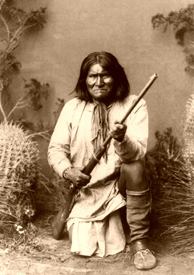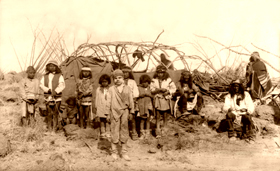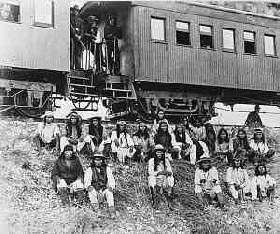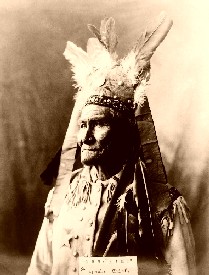Geronimo was born of the Bedonkohe Apache tribe in No-doyohn Canon, Arizona, June, 1829, near present day Clifton, Arizona. The fourth in a family of four boys and four girls, he was called Goyathlay (One Who Yawns.) In 1846, when he was seventeen, he was admitted to the Council of the Warriors, which allowed him to marry. Soon, he received permission; married a woman named Alope, and the couple had three children.
In the mid 1850s, the tribe, who was at peace with the Mexican towns and neighboring Indian tribes, traveled into Old Mexico where they could trade. Camping outside a Mexican town they called Kas-ki-yeh, they stayed for several days. Leaving a few warriors to guard the camp, the rest of the men went into town to trade. When they were returning from town, they were met by several women and children who told them that Mexican troops had attacked their camp.
They returned to camp to find their guard warriors killed, and their horses, supplies and arms, gone. Even worse, many of the women and children had been killed as well. Of those that lay dead were Goyathlay’s wife, mother, and three children and as a result, he hated all Mexicans for the rest of his life.

It was the slaughter of his family that turned him from a peaceful Indian into a bold warrior. Soon, he joined a fierce band of Apache known as Chiricahua and with them, took part in numerous raids in northern Mexico and across the border into U.S. territory which are now known as the states of New Mexico and Arizona. It was those Mexican adversaries that gave him the nickname of "Geronimo", the Spanish version of the name "Jerome".
In ever increasing numbers, Geronimo fought against both Mexicans and white settlers as they began to colonize much of the Apache homelands. However, by the early 1870s, Lieutenant Colonel George F. Crook, commander of the Department of Arizona, had succeeded in establishing relative peace in the territory. The management of his successors, however, was disastrous.
In 1876 the U.S. government attempted to move the Chiricahua from their traditional home to the San Carlos Reservation, a barren wasteland in east-central Arizona,described as "Hell's Forty Acres." Deprived of traditional tribal rights, short on rations and homesick, they revolted.
Spurred by Geronimo, hundreds of Apaches left the reservation and fled to Mexico, soon resuming their war against the whites. Geronimo and his followers began ten years of intermittent raids against white settlements, alternating with periods of peaceful farming on the San Carlos reservation.
In 1882, General George Crook was recalled to Arizona to conduct a campaign against the Apache. Geronimo surrendered in January 1884, but, spurred by rumors of impending trials and hangings, took flight from the San Carlos Reservation on May 17, 1885, accompanied by 35 warriors, and 109 other men, women and children.
During this final campaign, at least 5,000 white soldiers and 500 Indian auxiliaries were employed at various times in the capture of Geronimo's small band. Five months and 1,645 miles later, Geronimo was tracked to his camp in Mexico's Sonora Mountains.
Exhausted, and hopelessly out numbered, Geronimo surrendered on March 27, 1886 at Cañon de Los Embudos in Sonora, Mexico. His band consisted of a handful of warriors, women, and children. Also found was a young white boy named Jimmy "Santiago" McKinn, that the Indians had adopted some six months earlier in September. The "rescued" boy had become so assimilated to the Apache lifestyle, he cried when he was forced to return to his parents.
|
|

|
Also traveling with General Crook was the photographer, C.S. Fly of Tombstone fame. After the bands capture, he was able to take some of the most famous photographs in U.S. history.
The soldiers gathered the group and began the trek to Fort Bowie, Arizona. However, near the border, Geronimo, fearing that they would be murdered once they crossed into U.S. territory, bolted with Chief Naiche, 11 warriors, and a few women and boys, who were able to escape back into the Sierra Madra. As a result, Brigadier General Nelson A. Miles replaced Crook as commander on April 2, 1886.
At a conference on September 3, 1886, at Skeleton Canyon in Arizona, General Miles induced Geronimo to surrender once again, promising him that, after an indefinite exile in Florida, he and his followers would be permitted to return to Arizona.
The promise was never kept. Geronimo and his fellow prisoners were shipped by box-car to Florida for imprisonment and put to hard labor.
|
It was May 1887 before he saw his family. Several years later, in 1894, he was moved to Fort Sill in Oklahoma Territory where he attempted to "fit in.” He farmed and joined the Dutch Reformed Church, which expelled him because of his inability to resist gambling.
As years passed, stories of Geronimo's warrior ferocity made him into a legend that fascinated non-Indians and Indians alike. As a result, he appeared at numerous fairs, selling souvenirs and photographs of himself. In 1905 he was quite the sensation when he appeared in President Theodore Roosevelt's inaugural parade. Geronimo dictated his memoirs, published in 1906 as Geronimo's Story of His Life.
Never having seen his homeland of Arizona again, Geronimo died of pneumonia on February 17, 1909 and was buried in the Apache cemetery at Fort Sill, Oklahoma.
©Kathy Weiser/Legends of America, updated March, 2010.
|
Band of Apache Indian prisoners at rest stop beside Southern Pacific Railway, near Nueces River, Texas, September 10, 1886. Among those on their way to exile in Florida are Natchez (center front) and, to the right, Geronimo and his son. Photo courtesy National Archives.
Geronimo was one of the fiercest Apache Chiefs that ever lived.
|
|
Geronimo in 1887, photo by Ben Wittick.




No comments:
Post a Comment